#outtakes beloved i guess
Text


2077, 2095. Battle scars...
#cyberpunkaddict.png#oc: villiam bryant#virtual photography#male v#male v monday#cyberpunk 2077#cyberpunk 2077 photomode#cyberpunk 2077 screenshots#cyberpunk 2077 v#cyberpunk 2077 oc#masc v#cyberpunk#videogamemen#cyberpunk v#v cyberpunk#dailygaming#dailyvideogames#gamingnetwork#gaming photography#cyberpunk oc#outtakes beloved i guess#hes seen some shit#hes got a headache
144 notes
·
View notes
Text



Suraj Kennedy- my #kmik contestant! proper intro post coming later today 💖
#ts4#the sims 4#ts4 edit#ts4 screenshot#suraj kennedy#these were the outTAKES AHHHHHH#i'm ?#i?#hello?#ts4 photoshoot#he's 595506 years late but he's HERE#i love shan i love kmik i love suraj he's my new blorbo#hyperfocusing on this sim rn#i bet y'all can guess what gshade preset this is easily#wooldawn my beloved <3
245 notes
·
View notes
Photo


I also really like how these two turned out
#strange communication#NG outtakes#johanna my beloved <3#alexander!! my friend alexander!!#mrs goth please come get your son he's distracting the class#or I guess it would be ms bachelor now huh 🤭
1 note
·
View note
Note
If this is a weird comment you don't have to post it, but listening to E a lot I notice there are a bunch of idk? sounds in his songs that I guess they'd edit out now. you mentioned him laugh in Power of My Love and I hear it EVERY time now, but there's a lot of other stuff too that makes the recordings sound so real.
not a weird comment, i love this actually, and it's true.
i think it's a combination of factors. obviously, no digital editing (and no auto-tuning, which is why his studio vocals and his live vocals are as close to identical as they are. studio recordings are cleaner due to the setting and equipment, but the timbre and tone, the color, the melodic quality, that was truly the man's voice), although engineers could still clean things up in places, and lay in background vocals and further instrumentation etc, it was a bit more involved/arduous as a process and the central recording probably didn't get fiddled with as much. i'm not going to say i'm super well-versed on production of the time, but of course computers and digital mixing, snipping together various takes, etc, today can alter a LOT of what's captured to make it more "flawless." if you listen to any of his rough studio cuts/outtakes, you'll hear him rehearsing, changing up tempos, deciding on different arrangements or following instruction, (messing up lyrics and laughing and being a weirdo lmao i love him), clicking into how to get a song to work.
i also think it has something to do with E's particular technique and delivery, where he breathes is often very deliberate (try singing along and you'll notice how measured and controlled he was at this and the way it emotionally affects his delivery). i mean, as an example that isn't the power of my love laugh™, you can hear him gulp slightly at the beginning of in the ghetto (in the rest after "as the snow flies"), whether that's direct emotion or nerves or just how he was getting the song out. there's a moment in another song where you can hear what i think is the clink of his rings against the microphone. the memphis sessions have a LOT of the raw studio sounds left in. some of this is also that he...did not sit still (affectionate), so some of that fidgeting and rustling and personality is all captured in the recordings. listen to true love travels on a gravel road (my beloved), and there are a bunch of the organic moments right there. especially between the first chorus and the second verse - between "ohhh, true love travels on a gravel road" and "down through the years..." like four different things audibly happen. you can tell when he's playing around and exaggerating some of his vocalizations and quirks and trademarks, leaning into it - which he did in places in the comeback special too, because he knew exactly how to utilize/distill that, and the way it would transfix the audience, he just had command of that to unleash however he chose. (or whatever. he decided. to do. at the end of such a night). it's also why it's really apparent in a song when he smiles, which is one of my favorite things in the world, when you can HEAR a smile in a song. not every artist is easy to detect this with, but he is, and it's so warm.
what i really really love about this with him is it makes the songs so present and lived in and felt, all these unfiltered and natural details still exist in the tracks and so does his personality. then when you listen to the concert recordings, the only significant difference is stuff like banter with the audience or switching up bits of arrangement for the show, but the emotion and the amount of himself he put into everything is as real/accessible/clear in the studio as it is on the stage of the international or anywhere else. it's such a vibrantly alive aspect of his work that i believe it's part of why it's endured the way it has tbh - it still feels like he's right there about to pull that gold curtain back again.
#anonymous#letterbox#the thing is if you send me an ask about this i will write an essay#elvis presley#i was a dreamer#music expresses that which cannot be said and on which it is impossible to be silent#*
52 notes
·
View notes
Text
guess who started a spicy Patreon?
Me, it's me, I started it
If you're a fan of my spicy penname works, including GREEN AND GOLD (a MFM Femdomme romance featuring a Leprechaun King who's into financial domination) and BLACK AND SILVER (A Plus Size Witch and Pleasure Dom Incubus romance with a special appearance by the most beloved side character Boris), then this is the spot for you!
We've got bonus chapters! We've got original spicy short stories featuring all your favorite characters! We've got outtakes! And we've got so much more!
The October short story line up included a bondage and wax play scene with my MFM trio, and a sexy game of hide and seek and some consensual biting with your fave Pleasure Dom and his Witch <3
So come be a smut loving heathen with me! It's sinfully fun ;)
#Lauren does stuff#my books#my writing#Green and Gold book#Black and Silver book#spicy books#spicy content
3 notes
·
View notes
Text
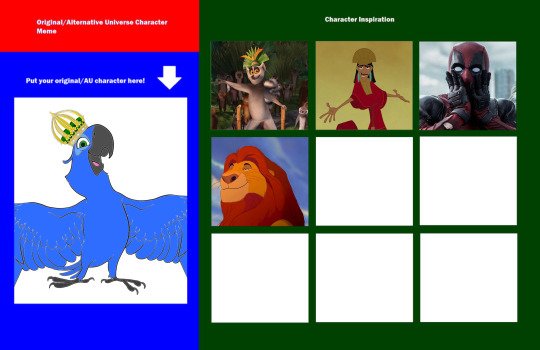
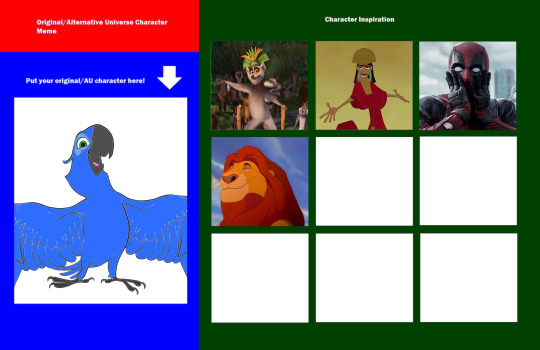
I previously briefly talked about Rio's personality. So, continuing from my last post, here's two versions of my character's personality inspirations. The only difference between them being Rio's appearance with and without his crown.
Like King Julien from the "Madagascar" franchise, Rio sings "I Like to Move It Movie It" in both "Rio" movies. If "Rio 3" happens, I'll try to find a way to fit it in, unless it doesn't get featured in the proposed third movie.
Like Emperor Kuzco from "The Emperor's New Groove" franchise, Rio narrates his own stories as a voice-over. But he will occasionally pause the movie sometimes and show up to either explain things in further detail, or just poke fun at some of the characters or even the setups.
Like Deadpool, Rio's fourth wall-breaking is used in-film and during the times when he pauses the movie. He even points out the obvious on how the whole thing is a movie, or even mentioning the audience from time to time. He'll also mention stuff that Fox owns like "X-Men" and "Ice Age". There's even a logo joke I thought of for either "Rio 2" or "Rio 3" where after Scrat falls off the Blue Sky Studios logo, Rio will sit on the "e" in "Blue", which breaks off, due to Rio's weight. Thus, the logo would now read "Blu Sky Studios" before fading to black.
Like Mufasa, I thought my character could have some similar papa wolf kinds of features. Even going as far as banishing Nigel for attempting to murder Blu, which should be punishable for attempting to murder royalty. But he isn't without his loving qualities, as well as the attention he gets from the birds and humans. Not only is he beloved and respected, but he's also a fair monarch who knows what's best for his subjects, including his son, and his family. He will occasionally give good advice if he needs to, like any father or parent would for their son(s)/daughter(s).
I guess he's also got some of that flair that screams "game show host", to some degree. He also acts as if he were an animated movie star, like how in some movies, like "A Bug's Life", "Toy Story 2", "Monsters Inc.", and even "Mr. Peabody and Sherman", they show outtakes during the end credits, which depict some animated characters like they were actors from a live action film (Click here to learn more about where I'm coming from with this). I don't know if I should do fan outtakes for "Rio" and "Rio 2", but I don't think it's a bad idea, if I could find what I think would work best (ex. After Blu's drawing in the dirt, Rio would draw an acorn in the final film. But for the outtakes, he would draw different things like Wonderbot ("Robots") and maybe a sloth that almost looks like Sid ("Ice Age") before drawing an acorn.).
Credit for this template goes to DeviantArt user TXToonGuy1037
#meme template#Rio#rio movie#rio 2011#Rio 2#blue sky studios rio#Rio (Rio OC)#Rio (Rio)#my oc#King Julien#Emperor Kuzco#Kuzco#kuzco fanart#Deadpool#Mufasa#character inspirations#my art
1 note
·
View note
Note
omg i need to know more about rafe going to her house the next day to apologise?!!!? 🥺 i love that so much (also did he get in a lot of trouble with ward when he got home??? and how was his eye the next morning lol)
ermmm ok perhaps i lied when i said i had no more outtakes to post. here u go my beloved new light annotations anon (i did not edit this one bit and i cut it bc i didn’t think it was working so pls lower your expectations to the floor. and then go below that) originally supposed to be the second half of all i want blurb
warnings: mentions of the fight/injuries from all i want, err that should be it besides swearing?
sorry if I was harsh last night, just wanted to—
how do you feel today—
hope your dad wasn’t too upset with you—
hi rafe, feeling better? i’m sorry if—
You groaned, deleting every single text before you even sent it, throwing your phone across the couch instead.
“Uh oh,” your dad says. “Is it boy trouble? Please don’t let it be boy trouble. Not yet.”
You don’t even smile at his joke, because he wouldn’t technically be wrong. “No, I’m good.”
“Good.”
“Y/d/n,” your mother chides, seemingly appearing out of nowhere. “Did you talk to her about curfew?”
You sigh, knowing this was coming. When Kelce texted you the SOS last night, you knew your parents would see that you left the house on the security system. But you didn’t even weigh the consequences for a split second, just slipping on your shoes and sneaking out as quietly as possible, leaving that for tomorrow. You just wanted to get to your friends and make sure they were safe.
“Ah. Yes,” your dad says, putting his newspaper down. He points at you. “Stop breaking curfew.”
You give him a salute. “Yes, sir.”
“Thanks.”
Your mom looks between the two of you in indignation, her mouth hanging open.
“You can’t just—she snuck out at two in the morning, we have no idea where she even went last night.“
“Where’d you go?” your dad says, looking back at you.
“Margot wanted to get shakes,” you lie easily, mentally noting that you need to text Margot later to vouch for you. “At that one 24 hour diner.”
Your mom blinks. “That filthy little hole in the wall on the Cut?”
You furrow your eyebrows. The diner was fine, and it wasn’t even that deep into the Cut. You went there with your friends all the time, always tipped the wait staff well. You went just last week with Rafe so he could help you study for your math test—you insisted you pay since he was helping you, but he took care of the check before you could even get the chance. You loved it there. “I mean, s’not exactly—“
“I don’t want you going there anymore. You know we don’t like you on that side of town,” your mom continues, flitting about the room, opening the drapes. “No more, understood? Not at two in the morning.”
“Yes,” you say, trying not to roll your eyes because you can feel your father looking at you. “Won’t happen again, sorry.”
“Apology accepted,” your mom says, looking satisfied. “You really should stay away from there. Heard the Cameron boy got into another fight last night down there.”
You freeze.
“He’s a trouble maker, that one,” your dad says, flicking through his newspaper leisurely.
“It’s not—he’s not… Rafe’s a good guy,” you defend weakly.
“Sounds like it,” your mom says sarcastically. “Some company you keep. Guess I shouldn’t be surprised, knowing the Camerons. New money from the Cut, tale as old as time.”
“He’s still got time to sort himself out,” your dad says, looking over at you above his paper. “You’re just kids.”
“Hm,” your mother says. “Such a shame, too. He’s handsome. Promise me you won’t turn out like that, Y/n? Or end up with someone like that?”
“Mom,” you groan.
“Which reminds me!” She clasps her hands together. “I was talking with Griffin’s mother, Christine. You two should—”
“Okay. I’m not listening to this anymore,” you declare, standing up and grabbing your phone. “I’m getting coffee.”
“But don’t be late for the ladies’ luncheon at the Island Club!” your mom calls after you.
“Wouldn’t miss it,” you call back, back turned as you exit through the garage. When you press the button to lift the door, you pause halfway inside your car when you notice Rafe walking up the end of your driveway, hands stuffed in his pockets, a fresh bandaid over his eyebrow.
“Rafe?”
He looks up at your voice, smiling sheepishly as you meet him in the middle. “Hey, Y/l/n.”
“What—what are you doing here?”
He sighs, a hand coming up to scratch the back of his neck. “Just wanted to apologize, I guess. For last night.”
“You could’ve texted,” you smile.
“Ah. Dad took my phone.”
You feel your smile slip off of your face. “Oh, I’m sorry. Was he… how did that go?”
Rafe just shrugs, hand dropping to his side. “Could’ve been worse, I guess.”
“Right. I’m sorry.”
“Don’t be, it’s my fault,” he tells you, eyes sad. “I’m sorry, again. You’re—you are way better of a friend than I deserve.”
“Rafe…”
“Thanks for always having my back,” he continues, hands back in his pockets as he rocks on his heels. “Just wanted to come say that, I’ll get out of your hair.”
You just nod, a little shocked at his earnestness, watching him head back down your driveway before speaking again.
“Rafe, wait!”
He turns around, looking at you expectantly. You feign nonchalance, tossing your keys back and forth between your hands while your heart threatens to beat out of your chest. “I was just about to go to the diner, if you wanna come.”
“Yeah?”
“Yeah.”
“Alright,” he shrugs, signature grin on his face as he heads back up the driveway. “Can’t have you sitting there all alone like a loser, anyway.”
You look over at him as he settles into your passenger seat like it’s his second home, like the two of you hadn’t been here last night under very different circumstances. Immediately turning down your AC and flipping to his favorite radio station. He’s telling a story about the party last night and you just nod along, thinking about what your parents said about him ten minutes ago. What he said, about how he doesn’t deserve you.
Maybe he hadn’t meant it in that way, but you know you’d let Rafe Cameron have you in just about any capacity he wanted. Even if it’d probably never go beyond this, just two friends going to grab coffee on the wrong side of town.
#new light hcs#i love that i agonized over all of these scenes trying to make them work#and now i just. don’t care! cause like 10 of you will read them when i don’t do tags or a taglist
67 notes
·
View notes
Note
hi nikki jie i finally finished rereading dream catcher and omg askdkskjdjsa iM -
wOW it was absolutely incrediblee im so full of emotions rn asfjsk i read ch 5 & 6 just now when i was otw to sch to study before cca (pls omg my heart was in shambles i had to take a few min to compose myself aft i reached the library 😭) then i just read the last chapter otw home and im so !!!!! i think ch 6 would be my absolute fave, maybe cuz that was like the climax of the whole story haha, but like it was such a roller coaster like omg all the intensity of keiji trying to save her, and then my soul was healed when they were talking in that dreamscape and him finALLY realizing he was in love with her, and then you stabbed me through the heart when his memories started slipping away 😭 and like this trope of a character giving up their memories of their beloved just to save them has soo much angst potential but is too underrated and you used it so beautifully here and my heart was physically aching while i was waiting for my bus T^T aND ch 7 when akaashi was so upset he still couldnt remember her name, and when he finally heard toya-chan at the florist askdjsj omg my heart!! 🥺❤️ i love all the flower languages and all the sky and celestial imageries that you used here and it was really soo beautiful when akaashi was realizing he was in love with her,, and i also loved how you described all the surroundings (i felt his nostalgia when he visited her village, the shrine dreamscape, the forest shrine) in ch5 especially like it felt sO REAL and there was such a clear image in my head it was amazing,, i think the reveal of her being the florist didnt hit me as hard this time cuz i reread it already knowing it was her, but i remember being so shookt the first time i read it and being so impressed that everything was soo well thought out,, i absolutely loved it and im really glad i reread it heh
oh and omg i almost forgot to mention but if it wasnt obvious i absolutely adore moriko??? i really love how she views the world, how she makes everything so simple; time should be spent with the people you love, and you should do things that make you happy, her deciding to become a florist simply because she loved the look on people's faces when they bought flowers 🥺 she's so reckless and brave and sweet and she's just absolutely perfect 😭
AND you must be annoyed cuz this is like the 192388th time im saying this but 'when the sun loves the moon'??? IM RLY SO EXCITED OMG YOU HAVE NO IDEA askdksjsj ill be looking forward to it!!!! i cant wait to see the outtakes too 😆
and aaa i saw you've been feeling lonely while your husband is back at ns why must sg do this 😭 is he gonna be back soon ? either ways, i hope you feel better soon!! have a good weekend nikki jie!! ❤️ ~ ann :>
i'm just...speechless that you'd even take the time to re-read dream catcher. i think it's one of the pieces that i still can't believe i was capable of writing, especially chapters 6 and 7 - the dreamscape and akaashi's memories returning back to him is prob the best writing i've ever produced LOL (is it shameless of me to say that?)
but yeah i think bcos the fic is set up like a romance-mystery, bcos it has a non-linear timeline, i really had to plot the whole thing out, leave little clues here and there, rely very heavily on the imagery like flowers and sky and stars and fire to really carry the story. it's definitely another instance of me torturing akaashi, but i think his character lends itself very well to a fic like this. i love love the trope of losing your memories to save someone - i think i grew up watching a lot of hk dramas and i can't pinpoint which it happened in, but this trope really stuck HAHA. and yeah there's so much angst, delicious angst there isn't it!
and omg moriko moriko, that reckless, wise, sweet forest nymph. she's...definitely has the sunniness (like bokuto) and i think that initially draws akaashi in, but she has q a lot of layers bcos she's brave and strong yet doesn't even think anything abt her strength, and that's what i think is amazing abt her. she's someone who marches to the beat of her own drum, she doesn't give a flying fuck about the world thinks. she's just unabashedly herself. that's what akaashi ends up falling head over heels for.
HAHA when the sun loves the moon is gonna be a fun ride methinks? it was such a blast to write bokuto's character, and i loved the whole process of coming up w a reader-chan that fits him, that fits his larger than life, bombastic personality. i've definitely poured a bit of my soul into her (like i do with all my readers / mcs) and i hope you'll like her too :)
mr nikki is back! but he's been away playing in some competition so....home alone i guess? haha.
#Nikki chats!#ann<3#i love all your reblog tags#oftentimes i read them on the mrt#then i tear up like a fool#bcos how why i don't deserve your rb tags#you sweetheart ily
3 notes
·
View notes
Text
Back to Field, Season 5, Episode 14 + Outtakes with Producer Zhang
- Mao Buyi was quietly telling Zifeng about how he was worried about performing his new song. It was cute, haha.


- Wang Tao and Huang Lei sharing a chuckle over how serious Yixing, sorry, Zhang PD, is about organizing the concert.

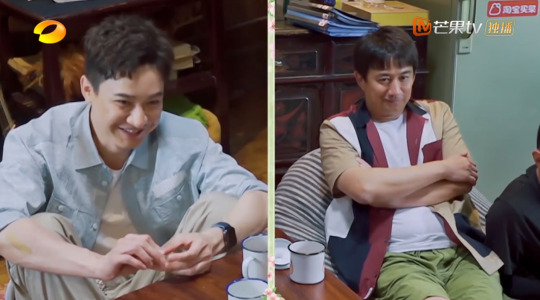

- In a previous season Pengpeng and Meimei had tried to do Xiangsheng XD (Which is like ancient standup)

- Mao Buyi had apparently been a guest on that episode, so they were like “hey, you should do xiangsheng too!” and he was like yeah no thanks lol.

- Wang Tao, Lv Siqing, and Chen Sa practising 一步之遙. I had to look up this song because I definitely recognize it. It turns out 一步之遙 is the Chinese name for Por Una Cabeza
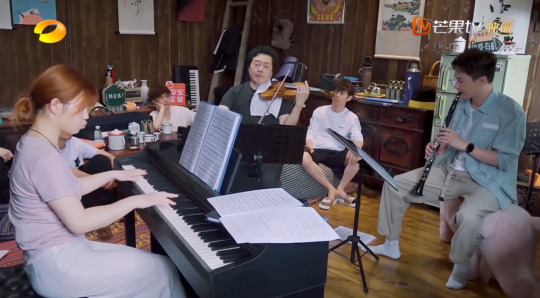
- Mao Buyi helping Meimei with the song she’s singing. The thing is, she’s singing a song that’s meant for a male voice, so she��s singing an octave higher, which is higher than is comfortable for her.
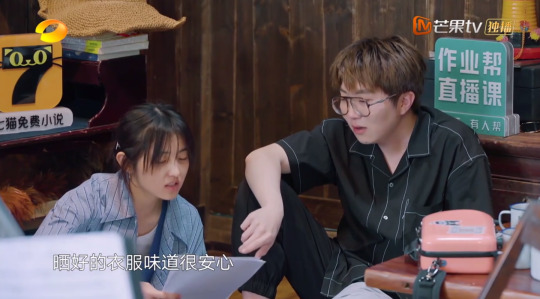
- Construction time!!! My favourite.

- Yixing asked Pengpeng to do a solo dance, which he did do for like five seconds
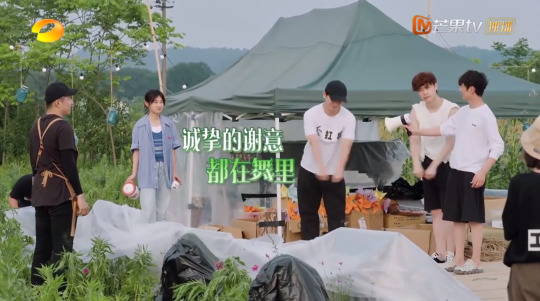
- The cast laughing at the fact that Yixing literally spends his days and nights working on music, even as the others are eating dinner.

- Basically they said that Zhang Jiashuai was so shook by the musicians' practice that day and he would not shut up about it, so he was inspired and motivated to work on his own music.




- He wanted to adapt and tweak Xiangjiang River but I guess it wasn’t up to his standard so here he is being disappointed in himself lol.



- Then basically the show included a bunch of clips where he was showing his music to other people and how he’d work on it again and again and again. Nothing new here, this is the Yixing we know and love.




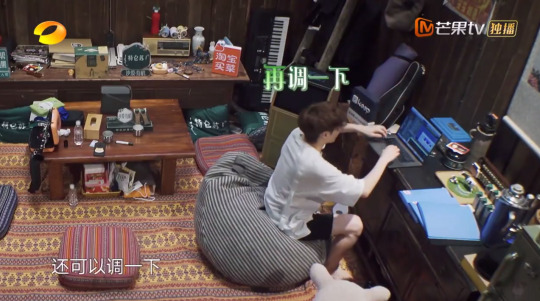

- It was super rainy, so the concert had to be postponed. Ouyang Nana also arrived, so now they’re practising with her.

- More edits.
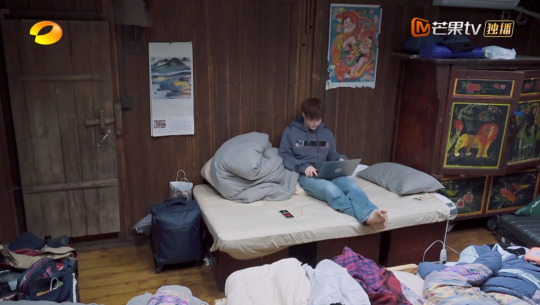
- Literally as they were walking to the concert stage for practice, Yixing got ideas for his music lol.

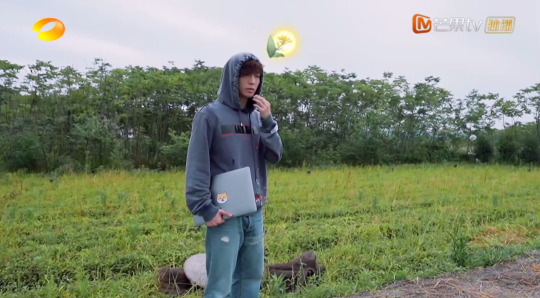


- Liu Xiaoyi was the stage director :P Basically he was assessing the sound and acoustics.

- Lv Siqing and Mao Buyi were just chillin, and Yixing was like “nahh gotta make more edits.” And then the rest of the cast are just walking around them.

- Nana was super hyper lol. Here she is skipping with Zifeng on the way to the concert.

- Yixing had given his final copy of his song to the sound director (I think it was his sixth copy). He was like “this really is the last version!” And the sound director was like “even if it isn’t the last version, there’s nothing we can do about it,” because they have to finalize the tracks before the concert lol.
- The audience has arrived~

- During Mao Buyi’s performance, Yixing was helping this worker who was making some smoke for ambience lol.



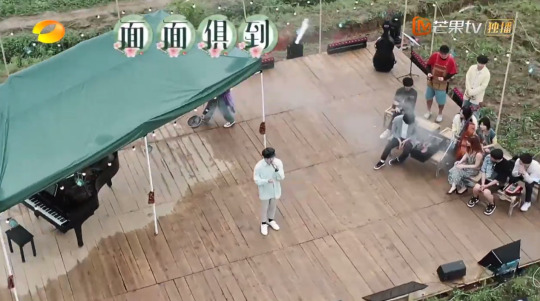
- Yixing went so hard XD
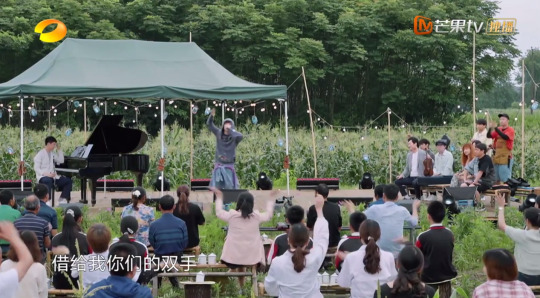

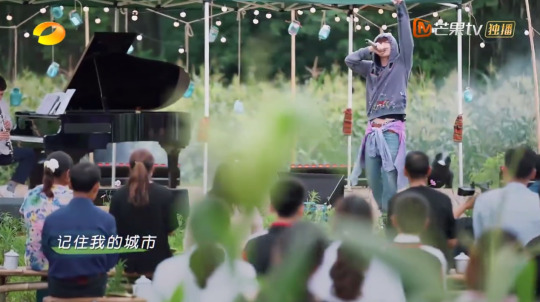

- PENGPENG!!!!!!!!

- XD There is no difference between a concert at a stadium with thousands of people and a concert in the middle of a field with less than 50 audience members.

- I just thought it was cute that Wang Tao was leaning on Huang Lei’s shoulder :3
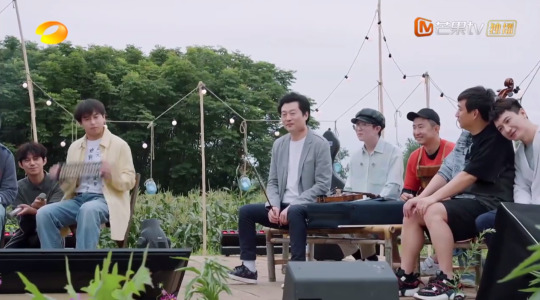
- Other than the people in the audience, there were people by the roadside enjoying the music too :3 He Jiong gave them a shoutout.
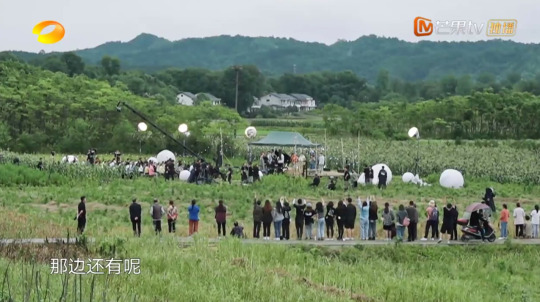
- Sentimental baby recording videos and taking photos of Mushroom House.


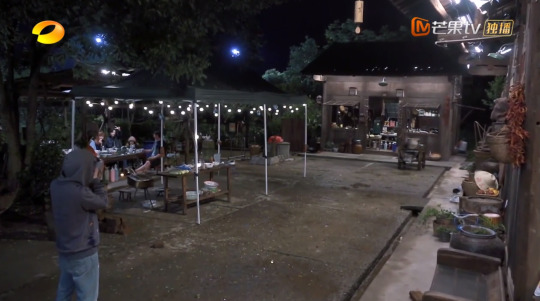




- Nana is so cuddly lol

- uwu

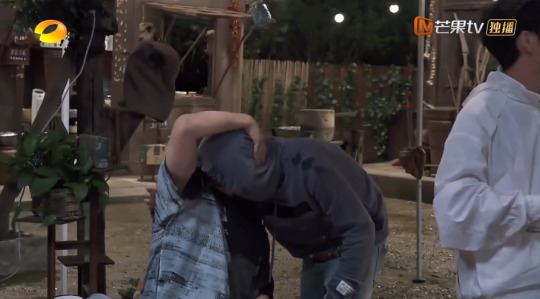
- What’s really interesting is that Nana calls Yixing “Lay-ge” as opposed to “Yixing-ge.” Anyway, she asked him to take photos for her and Zifeng :3 So cute.

- Huang Lei already went for a run and he has his obnoxious alarm on blast



- The last meal :(

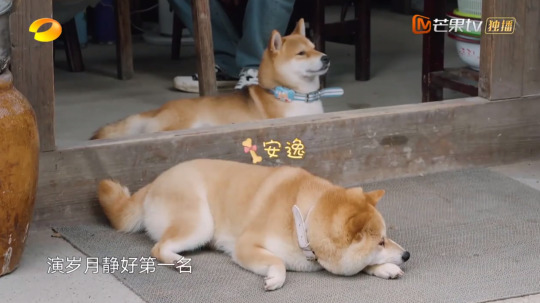
- Yixing thought that Xiao O’s collar seemed tight so he wanted to fix it for her. And we know how much he loves teasing Xiao O for being a glutton so he was like “you gotta eat less homegirl your collar’s choking you.” He said it was bothering him since yesterday lol.


- Yixing’s hair getting messy on the car ride lol. They were going on one last trip around town, including the trees they planted, and the library.

- At the library they played a game, a race to find the five words 向往的生活 in a random book they chose. Yixing was like “I’m gonna win, because I have the dictionary” XD
- Goodbye Yixing :( He actually looked kind of down as he was leaving?



- Meimei leaving :(

- And now Pengpeng :(
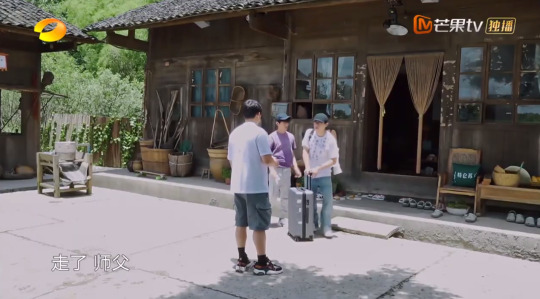
- Of course, the dance


- I’m kind of glad that the series didn’t actually end with the goodbyes, because that would’ve made me way too sad lol. Instead we have bits and bytes of shenaniganery.

- Yixing was the overseeing producer while they recorded their 吹牛皮 song. Of course he was very detailed with his direction. And he was so generous with the praise. I guess that’s his way of motivation.
- Pengpeng was embarrassed lol.

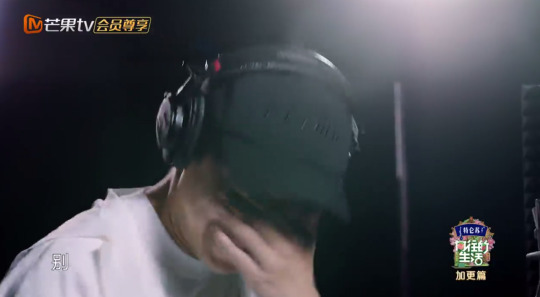
- Lots and lots of praise for Mushroom House’s beloved Meimei. He was like omg have you ever thought of being a singer? Are you interested in joining CHROMOSOME??? This boi istg. It’s cute though. His encouragement keeps the people in the booth relaxed.


- Yixing liked Meimei’s voice, so he asked if she could do harmonizing. She said she couldn’t, so Yixing gave her some instructions. This boy is serious.
- Then he was like “next time you release an EP come find me!!!!!”
- Huang Lei was like “lol Yixing just gave up on harmonies for Pengpeng.” And then he was like “Pengpeng’s career success has just been because he’s gotten people to give up on him” lol.
1 note
·
View note
Text
The Car Ride
A/N: I got an idea some days ago and needed to write it down sooo bad... it’s mostly fluffy and i hope you will enjoyed it. I had a lot of fun writing this, and i hope you don’t mind my bad grammar and everything,... i only write things when all the planets align :3
He was still confused when he sat down in the passenger seat. His beloved MC sat down in the driver seat of her car. “Can you tell me again why exactly you are insisting on driving the car by yourself?”
“Because, driving is fun for me, Jumin, especially if it’s my very own car.”
Her gaze went over to dashboard to the speedometer, when she turned around the key, one foot on the clutch, to start her car. The motor started to purr softly and Mc turned her car on the empty street. It was early in the morning and the sunshine fell through the glass, lighting up their faces.
Jumin tilted his head, while looking at her with curiosity inside his gaze. The young CEO was still amazed how she managed to find joy in such small things, and wondered if he would ever be able to have the same positive attitude as her some day.
Well, it already got much better when MC entered his scheduled life and teaching him how to feel.
She changed the position of her hands, one on the steering wheel and the other on top of the gear lever. Her eyes darted on the streets a concentrated look inside her gaze. A few strands loosened from her already messy bun. Stunned by her beauty , the dark haired man even forgot how to breathe for a few moments.
The radio played a calm song Jumin didn’t know which one it was but he knew MC liked it. As soon as she recognized the song, the young woman starting singing softly in sync with it. The moment was perfect. She looked so happy and joyful. Jumin laughed softly, when she looked directly into his eyes, trying to figure out what he was thinking.
“Are you still uncomfortable? Just take look outside then! Everything is so colourful today, it’s so beautiful!” You are beautiful, he thought.
“I.. I am more than comfortable right now, MC. You’re driving nearly as good as Mr. Kim”
She snorted. “Really?” “Yes,” he chuckled “even though you tend to drive a little bit rougher and faster… more like Saeyoung.”
With her gaze back on the street, he saw her cheeks blush. A beautiful pink.
It was his wish to drive to the beach together and hers to drive by herself , wanting to make a roadtrip with her still new boyfriend. At first he was sceptic but after seeing her beauty while she drover further and further away from Seoul into the direction of the beach, he did not regret to accept her decision.
They talked, laughed and hummed together for quite some time, when both of them fell into silence. Not an awkward silence though. Both of the young people followed their own thoughts inside their mind.
MC still thinking about how the hell she would find the way to the beach and how adorably Jumin looked with sunshine in falling onto his dark hair and into his dark eyes, making them almost seem like stones lying inside a river bed.
Whereas the young man still admired the spark of joy that sat next to him in the driver seat. Amazed by her delicate finger on the lever, and the soft but firm tension in her arm muscle to hold the steering wheel. He still couldn’t believe she was his girlfriend.
The sudden feeling of her hand slowly stroking his knee pulled him out of his thoughts. “Hmm..?”, his eyes still resting on her hand. “You know Jumin? I really love you, and i am so happy to have you in my life now.”
“I love you to MC, I guess i am a lucky man then.“ he chuckled again and took her hand to his mouth, softly placing a kiss on it. “It’s not everyday someone finds a ray of sunshine like you. You always make my day brighter.” This time she didn’t know what to say other than “Thank you, honey”
~Outtakes~
When i wrote this down on paper, it went into a different direction… which was slightly nsfw (but because of my lacking talent to write in general, i failed horribly…) anyways here are the outtakes
Deeply in her thoughts she started to slowly run her fingers over the gear lever, even played with it. It looked so wrong for Jumin, who suddenly felt a hot flush rise up his cheeks. Just turn your head away from it, he thought, but couldn’t, god why is he still looking?!
It almost looks like she… NO!!! He reached for his tie to loosen it a little bit. Why did it turn him on so much? He needed air.
His dark eyes wandered over the dashboard trying to find the AC. When he found the switch he simply turned it on. Suddenly it got so loud inside the car, strong wind blowing directly inside his face, disheveling his hair even more than before.
MC laughed before she turned the AC off. “I’m sorry, i forgot to tell you that my AC is a little bit weird, it’s… stronger than others for some reason.” The young man chuckled, hoping she wouldn’t notice his…situation right now. Well his face turned as red as a tomato by now and he glanced down to look at his trousers, where a bulge happened to grow... oh no.
When she softly put an hand on his knee he shook his head to pull himself together.
“What’s the matter with you?” she asked, turning her lovingly gaze to him. “N..Nothing, I just feel very… hot. I mean... warm!” he smiled and looked away to avoid her now smirking face - of course, she did notice... “Warm? You look, hmm.... nervous?”
#mysme#mystic messenger#jumin han#jumin x mc#juminxmc#shitty longcat#i am glad i finally got to write it down#hope you like it!#tumblr destroyed my paragraphs#but i am way too tired to get this done now!
40 notes
·
View notes
Text
This post is in memory of Spot the Plant (2019-2019)
Let us all press F to pay our respects in this moment of silence.
...
...
Okay, moment over. Steel is keen on keeping a pet so he can explore his more human side but Nate only agrees to it if the hi-tech himbo can keep a potted plant healthy for at least a week. I honestly really like how a robot like Steel can just walk around with few batting an eye. I guess the Earth in Power Rangers really has gotten use to advanced tech like with General Burke’s model rockets.
However, Vargoyle activates his Memory Pulsator to rewrite the memories of Coral Harbor’s citizens where Evox never attacked with Blaze and Roxy both Rangers in their minds. I really like it when the last episode is self-contained while doubling as set up for the bigger picture in TV shows. It’s something that Power Rangers has done really well. Yes, even in the earlier Neo-Saban Era. :P
Thankfully, Steel’s circuity negate these transmissions after Devon gets him his potted plant and lets him see the energy rewriting the Red Ranger’s mind. Though the transmissions must have a few side effects since Devon seems disinterested in the FRIGGIN’ robot he’s never seen before and even asks, “What’s a morpher?” Guess the cast of Megaforce was hit with the Pulsator. :/
Steel convinces Devon to get him into Grid Battleforce where they see Blaze and Roxy just waltzing through the front door. Unfortunately, Ben and Betty confiscate their wrist-coms even as Steel does his best impression of Thing from The Addams Family. Seriously, Steel’s own left hand kicking tail was just a treat in and of itself. They just remembered that one gag and had a blast with it.
Vargoyle comes in to take on his robotic Ranger rival while he can’t morph. Devon uses the Karate skills he used on Blaze with a friggin’ pipe and helps Steel play keep away with Spot the plant, even tapping into his Cheetah Speed. I always felt that the Disney Era’s Civilian powers were weird for disappearing when the Rangers morphed but this and Go Busters seem to solve this issue.
Alas Vargoyle destroys our beloved Spot and even put Steel out with the trash for all his trouble. Now that’s just cold. Luckily, Devon get their wrist-coms back so they can get to the Channel 10 News Station. Meanwhile, Blaze and Roxy have the other take the mega transporters for a “project.” The Avatars even sabotage the real Roxy’s stasis pod for what I only guess is a sort of insurance.
I love the shot where Roxy is shown still sleeping while her Avatar messes with her pod in a brilliant show of green screen tech. I’m calling it now. She made it so that the Avatar’s powers would be return to her original body should she be defeated in battle. This way Evox has a mole on the inside or somebody to carry out his will should he himself be deleted. I haven’t seen any spoilers so...
Devon and Steel make it to the station only to find the transmitter fitted with a force-field and the ladder electrified. Devon decides to go find the main power shut-down switch while Steel climbs the ladder himself. Bare in mind that his human part gives him pain receptors and his metallic body conducts the voltage yet he soldiers on towards the top. Spot would be proud, robo-dude.
Devon runs into Vargoyle guarding the main power switch with just enough Morph-X to use his Cheetah Speed. There’s a lot to love about this battle even if it’s lifted from Go Busters. They have the two battling each other at top-speed to the point that they run across the walls and ceiling. It really takes advantage of the close-quarters in the hallway compared your typical open field battles. :)
Perhaps what I love the most about it is how in Go Busters, Hiromu’s battle with Danganloid was made specifically for Mission 10 only and something Enter put as an mere obstacle for his scheme of the week. Beast Morphers, on the other hand, recontextualizes this single battle as the final confrontation with a more recently reoccurring villain built up since Episode 2. Adaptation is just amazing.
Steel reaches his limit just as he busts up the Memory Pulsator. The other Rangers regain their original memories but Blaze and Roxy retreat with the transporters. Devon dispenses of Vargoyle is a really cool strategy of tossing his blaster and speeding up to get a few hit in before combining it with his saber so he can get a close-ranged clean shot. Now I see why they choose this battle.
Steel is brought back to GB for a full system reboot while the main trio go out to face Vargoyle’s Gigadrone. Vargodrone? Anyways, Steel pulls through and is rewarded with a trip to the pet shop. Unfortunately for Devon, he picks a dog and cause the Red Ranger to freeze up. It’s nice to see that weakness again though I get why Beast Morphers doesn’t milk it too much like Go Busters did.
Steel does realize that he might not have the time to care for Spot 2.0 as a Ranger and give it to a young girl in a scene that made me go, “Awww...” Though it’s a shame we couldn’t get a dog as a mascot for the show, I would imagine that Devon’s actor might find it challenging to freeze up unmorphed. Though imagining all the outtakes would make it totally worth it. Just saying. :P
Meanwhile, the Bumbling Burkes travel across the universe due to a cracked Mega Transporter. Seriously, they’re in space for a second and are totally fine without a suit. Then again, Mike Corbett was totally fine after losing the Magna Defender power in the vacuum so I guess they’re being consistent. In a way. :/
Next time, Evox’s latest power play truly begin...
#Power Rangers#power rangers beast morphers#beast morphers#super sentai#tokumei sentai go busters#go busters#hasbro#hasbro studios#allspark pictures#toei#toei company#nick#nickelodeon#nicktoons#devon daniels#ravi shaw#zoey reeves#nate silva#steel silva#blaze and roxy#blaze#roxy#evox#scrozzle#vargoyle
8 notes
·
View notes
Photo

Manhunt (2018): not one of the good John Woo movies, but those days are way, way behind us. It’s Woo doing a kind of self-parody and very consciously trying to make a “John Woo Movie”, fully in quotes, which is a very odd thing to see a director do near the end of his life (Woo being 71). Like, I’m not sure what this movie meant to John Woo, exactly, I guess. I think he was making fun of himself, but not a lot (?) because most(?) of the movie is just kinda rote garbage-- the actual plot is not great. But almost/sometimes-enjoyable rote garbage, at least, if you’ve got a few hours to kill waiting around inbetween things, which is how I saw it. Like, there’s a scene of a hitwoman eating soup that is kinda shitty in a way that’s weirdly likable (it feels like an outtake that they just included in the movie), moreso than the story being any good...?
Or there’s a decent action scene in the middle, and I liked when jetskis show up and the movie goes off into a John Woo jetski scene. Not a good movie but a bad movie that I’m okay with watching basically. That was a sad career to watch play out overall though because the Hong Kong stretch was really fun at the time. But yikes, the Hollywood stretch... Woo just got hired a lot to make movies that weren’t John Woo movies, was what it felt like. I mean, the Hollywood stretch literally culminated in a movie just called Paycheck. (I’d never messed with the Return to HK stretch of his career-- Red Cliff or whatever, until this showed up free on Netflix.)
I don’t know what happened with him, other than the good stretch had Chow Yun Fat and the bad stretch didn’t. Maybe Woo just needed that guy. You definitely feel his absence in Manhunt-- the lack of his charisma... But how many guys in the entire world have that level of charisma? Tony Leung was busy.
Maze Runner 3 (2018): this didn’t play out the way I wanted it to, which was that within the first 5 minutes, a giant anvil fall from the sky and kill the main character and his (very, very unlikable) love interest, so that the rest of the movie could be about the widely beloved Maze Runner character Minho running through a maze .... until exiting the maze, only to find himself in an entirely new teen action sci-fi franchise, built around the Milton Bradley board game Yahtzee. Saw it on an airplane, though, and not in a giant teen-imprisoning maze, like it was really meant to be seen. So can I really claim to have seen it at all? That’s the conundrum.
4 notes
·
View notes
Text
Pinky and the Brain: The Touching Story Behind the Strangest Animaniacs Episode
https://ift.tt/eA8V8J
Orson Welles is remembered for many things. His narration of War of the Worlds on the radio is legendary. He gave the world the groundbreaking film Citizen Kane. He schemed to the tunes of zither in the Third Man. He died voicing the planet-eating robot Unicron in Transformers: The Movie. One of the more obscure episodes in his life was when he was hired to record voiceover ads for Findus and their frozen food products.
Yes, it’s one of those things that’s just too weird to exist.
Once upon a time, Welles was tasked with recording lines for a peas commercial and things started to go off the rails. He and the directors didn’t see eye-to-eye, he didn’t appreciate any notes about his delivery, and eventually, he stormed out of the session, claiming that no money was worth this. Somehow, the audio was bootlegged and the situation became a ridiculous moment of legend.
Maurice LaMarche has had a long and storied career as a voice actor. He’s been Egon on The Real Ghostbusters, Kip on Futurama, Duke Nukem on Captain Planet, Elsa and Anna’s father in Frozen, and so on. LaMarche’s specialty is his Orson Welles impression, which not only pops up when he is playing the actor himself (as he did when he provided a voiceover for Tim Burton’s masterful Ed Wood), but when he’s playing the megalomaniacal mouse the Brain. LaMarche was very much aware of the commercial recordings and basked in the ridiculousness of it all.
LaMarche actually lampooned the Findus situation a few times on The Critic, where he portrayed Orson Welles both in a disastrous peas commercial and a video where he introduced a will reading, only to go on a tangent about fish sticks. It helped to know the source material, but it wasn’t necessary. These short gags played up the ideas that Orson Welles was a has-been and a glutton. That was enough.
Yet there was another LaMarche performance that was far stranger. The 52nd episode of Animaniacs featured a short cartoon called “Yes, Always” starring Pinky and the Brain. Usually, Pinky and the Brain were known for going on nightly adventures thanks to Brain’s overly elaborate attempts to take over the world. In this instance, it was nothing ordinary. It was a cartoon about Brain being asked to do voiceovers for frozen food commercials. All the while, he got in arguments with the director Pinkie and a nearby engineer.
In fact, the dialogue was taken almost verbatim from the original blooper tantrum. Brain replaced the promise of a sexual favor with, “I’ll make cheese with you.” Other edgier words were replaced with “shoot,” “tripe,” and “jiminy.”
This cartoon made less sense than the Critic jokes. It wasn’t in the spirit of what Pinky and the Brain were usually about. While there were kids out there who understood who Orson Welles was for one reason or another (I myself at least understood how one of Brain’s failed plans was a reference to Welles’ chaotic broadcast of War of the Worlds), it was a lot to ask children to play along with a take on a dead actor’s grumpy audio outtakes.
There is a rather sweet story behind the episode, though. While the “Yes, Always” episode aired on February 11, 1994, it was actually recorded on April 15, 1992. The day represented something truly tragic and, well…I’m going to let Rob Paulsen describe it.
I recently interviewed Rob Paulsen – the voice of Pinky – about the Animaniacs reboot, among other things. I asked him if there were any times he was taken aback by how weird a cartoon script was (inspired by that audio clip on the internet of Lion-O’s voice actor losing it over his hilarious Thundercats dialogue). I expected to hear about some wacky Cobra plot or something stupid the Shredder and Krang cooked up. Instead, Paulsen threw a curveball.
He started discussing Animaniacs and said that there was a Pinky and the Brain script that was too “inside baseball…a $300,000 in-joke.” Immediately, I guessed that it was “Yes, Always” and he happily confirmed it.
cnx.cmd.push(function() { cnx({ playerId: "106e33c0-3911-473c-b599-b1426db57530", }).render("0270c398a82f44f49c23c16122516796"); });
“None of us knew it was being written,” Paulsen recalls. “We got to work, and the scripts were on the music stands, and we started perusing. Right away, we all just went, ‘Oh my God’ and we could see Tom Ruegger and Andrea and the people on the other side of the glass because they were looking at us like we were opening a Christmas present. And we all started laughing out loud at the same time. Of course, Maurice was the star of this episode, he had yet to arrive, and we were all just slapping our knees. We couldn’t believe our good fortune.”
In addition to being a beloved voice actor and “a world class impressionist” and as Paulsen puts it “a freaking genius,” LaMarche was a standup comic before making it as an actor, and he was very close with comedian Sam Kinison, who had recently died in a car accident.
“One of Mo’s best friends in the world was Sam Kinison and he was at Sam’s funeral that day,” Paulsen says. “All of the producers knew of this going on, and when Sam died and Mo was going to go to the funeral, they held the recording of that particular episode till that day. So Mo shows up, and he’s a pro. He’s going to be able to pull it off…and man, when he started reading that script, I was sitting right next to him. I was just kind of looking out of the corner of my eye, and it was almost like he collapsed and put his forehead on the music stand and just said, ‘Oh my God. You guys, are you fucking kidding me?’ It was just fantastic.”
The producers gave LaMarche another nod during the session, as well, letting him deliver a signature mic check as part of the bit.
“The other thing is that Mo used that spot-on impression of Orson Welles doing the, ‘We know a remote farm in Lincolnshire, where Mrs. Buckley lives. Every July, peas grow there.'” Paulsen says. “Mo’s used that as his mic check for decades in Hollywood. Everybody knows that, regardless of the show he works on. The whole thing conspired to be a really powerful moment for Maurice personally, for the people around him, and a show that really left its mark, especially when they start do to a little homework, and they go, ‘Holy Shit. That’s a killer episode.’ And the way it was put together is even better because they were doing it for Maurice, and he deserved it.”
Animaniacs will be making its return to Hulu on November 20. It’ll be full of country goodness and green pea-ness.
The post Pinky and the Brain: The Touching Story Behind the Strangest Animaniacs Episode appeared first on Den of Geek.
from Den of Geek https://ift.tt/36FTBCs
0 notes
Text
Ravens and One-Eyed Cats, Oh My!
The unseen Ghost Host acts as a sort of ambassador, a go-between, someone equally able to speak to us in the mortal realm as well as to his fellow spirits (presumably). Other than a few directives from the Cast Member Butlers and Maids, telling us to get to the center of the stretching gallery, the GH is our only narrator and guide. He never really tells us what his motivation is in taking us on this little tour. Right up until the end of the ride, you don't know if he's good or evil.
We're so used to this arrangement by now that we forget that doing it this way was a choice. As it turns out, it was a choice made only a few months before the Haunted Mansion opened. Some of the rejected alternatives would have made for a very different ride experience if they had been implemented. One of these is fairly well known and has left traces behind in the ride. There is another one, far less well-known, which has left nothing behind. One thing they have in common is that both of them add an additional character who interacts with both the Ghost Host and with you, the rider.
Very different chemistry. This was not a trivial decision, as we'll see.
The Raven
Died in the wool Mansionites know a lot about this character, so if you're one of those, and you're impatient, you might scroll down to the Cat section, which includes stuff you've never seen, I promise.
Riders can hardly help noticing that there is a raven which accompanies them throughout the ride, starting with the Conservatory scene and ending at the entrance to the crypt at the end of the graveyard scene. There are five all together, but they are all supposed to be the same character. All it does is caw at us. Especially at DL, particular attention is drawn to it as we descend into the graveyard. Despite having our focus obviously directed at it at that point, we're gettin' bird noises and that's it.

Originally, the WDW raven sat on the branch right above you too, as you tilted back, but due to "guest abuse" it was moved back and put on a branch well off to the side. Ketchup packets, I imagine.
Caw-caw. At least the bird sounds real. According to Stacia Martin (The Sounds of Disneyland [Disney, 2005] 31), he was voiced by "Candy" Candido, best known as the go-to guy for basso profundo in cases where even Thurl Ravenscroft couldn't get low enough. (Candy must have had freakin' bridge cables for vocal cords.) What is less well-known is that Candy was extraordinarily versatile and could do very high voices as well. The same source says that Candy did the raven in Sleeping Beauty and simply hauled out his raven cry again ten years later for the Mansion.
Be that as it may, originally there were going to be several more ravens, including one in the stretching room and one in the foyer. (You can read about the latter one HERE). This was still going to be the case going into the spring of 1969. The raven was going to talk to you, along with the unseen Ghost Host. The 1968 show script which provided the basis for the "Story and Song from the Haunted Mansion" album preserves a lot of the raven's dialogue. The bird criticizes the stretchroom advice given by the GH ("He chose the coward's way! Caw-caw"). I guess the GH is a little miffed, because shortly afterwards he responds by warning you that the raven is a possessed creature, and its "restless spirit" may be looking for an opportunity to "better itself." This bickering leaves you wondering which (if either) of these voices from regions beyond should be trusted. But the raven is also the one who warns you about the ghostly hitchhikers at the end, so by that point you have probably come to trust the little guy. He even calls you "my friends," so you see? He cares. I guess there was no caws for concern. (Oh shut up; it's my blog.)
The eerie raven first appears in a Ken Anderson concept sketch. Marc Davis liked it and kept it, and it seems that there was never a time when it wasn't going to be part of the show.

Is the talking raven taken from the famous Edgar Allan Poe poem? If we're speaking of an indirect influence, the answer is an easy yes. Poe is indeed responsible for adding the raven to the short list of recognized Halloween critters (bats, spiders, black cats, owls). But even in a direct sense, the answer is yes. In an early script, the raven warns us about itself (huh?) and the hitchhikers, with "nevermore's" and "evermore's" sprinkled everywhere. The lines were recorded at one point by the incomparable Eleanor Audley (Lady Tremaine, Maleficent, Madame Leota). Warning! If you're an admirer of Ms. Audley's work (yes, yes, I see those hands), this excerpt is painful to listen to. But we historians cannot afford the luxury of pity.
Beware of Eleanor's Raven, Forevermore
[Audio Link]
Oh geesh, that was bad. Anyway, it proves that X. Atencio was directly influenced by "The Raven" when he tried to script the character. One problem with the raven—besides being annoying—was that it was too small to command your attention in some of the larger scenes. Maybe a bigger animal would work. Let's see...no, you can't have an elephant in a haunted house. How about a black cat? More specifically, how about an Edgar Allan Poe-inspired black cat?
The One-Eyed Black Cat
"The Black Cat" is one of Poe's better known tales, often anthologized, and read in many a high school English class. If you've forgotten how it goes, here's a severely abbreviated summary:
The narrator had a beloved black cat for a pet, but one day in a fit of alcoholic rage he gouges out its eye with a knife. Later on, guilt at the sight of the one-eyed black cat turns to resentment and he kills the animal. Later he finds (or is found by) another one-eyed black cat and takes it as a pet. In yet another one of his fits of rage he murders his wife and walls her up in the cellar. When the police investigate, however, the narrator is betrayed by the howling of the cat inside the wall, where it had been walled up with the corpse.
A much creepier Poe animal than the raven, certainly. Most Mansion fans know about the existence of the one-eyed black cat only from a couple of Paul Frees outtakes, in which he tries out his note-perfect Bela Legosi and Peter Lorre voices while using a revised HM script. Dude, when Count Dracula sees fit to warn you about a kitty, it must be one bad motorscooter.
Ghost Host Bela warns you about a nasty cat
[Audio Link]
Ghost Host Peter warns you about it too
[Audio Link]
As you can gather from those, X's cat was much scarier and more demonic than his raven. None of the cat's dialogue has survived, but X did a series of concept sketches. The notion that the cat would be co-narrator may even predate the notion of putting the earlier raven character into that specific role. It looks as if the black cat might first manifest itself at first as nothing more than an eye:
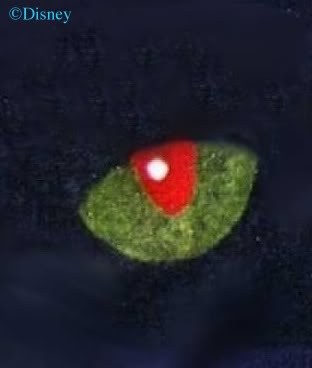
Apparently, the eye would morph into a shiny point of laser-like light, and a cat face would appear with only one eye. The first eye you saw turns out to be the missing one. From the looks of it, this loud and angry feline is looking for more than just a Little Friskies num-num.

The morphing continues, and the face rots into a more human form. Not surprisingly, this does nothing to improve its mood.
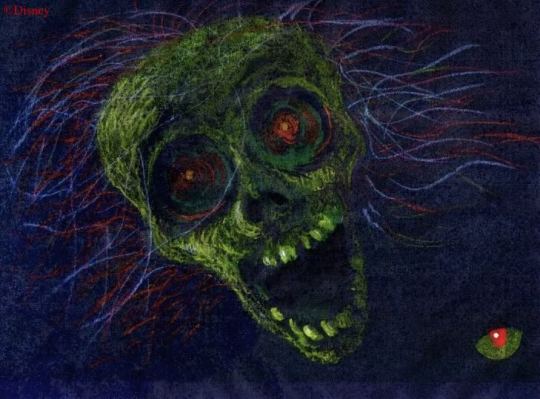
Good Lord. And how was this thing going to be presented? A projection? That isn't clear. It's possible that the "cat" was going to just pop out unexpectedly along the way in its various stages of demonic materialization. The face above looks a lot like a blast-up head in another X concept sketch. A quick look at some actual blast-up heads (inset) confirms that this is what the artwork is about.

So maybe our creepy "cat" was going to jump out and surprise us here and there throughout the ride. Good Lord.
When neither the demonic one-eyed black cat nor the "nevermore"-squawking raven ended up being used, the HM lost its only clear Edgar Allan Poe allusions (although you could make a case for a Tell-Tale Heart allusion in the bride's beating heart). It would have been nice if someone had told the composer of this WDW pre-opening publicity poster that the Haunted Mansion could no longer be accurately described as "Edgar Allan Poe-styled."

The black cat was a short-lived idea, with good reason. By having the Ghost Host warn you about a clearly malicious and dangerous creature like this one, he cast himself into the role of protector. He was there to help you. Similarly, in the 1968 script, the GH graciously informs you at the outset that you will not be harmed. That's very decent of him.
Too decent. Who wants Santa Claus for a Ghost Host? A haunted house is an allegory of life itself. You enter here and you exit there, and in between is a dark twisted corridor filled with frightening sights. You may get advice along the way, but you never have quite enough evidence to be sure that those voices have your best interest at heart. Do you really want to go into that haunted house that the neighbor kid put up in his garage for Halloween—the one who's a minor league juvenile delinquent the rest of the year?
Enter if you dare.
The Haunted Mansion is no different than any thirteen-year-old's spook house, and it's no different from life. Once you're in, you don't know if the Host is benign or malicious, so you have no choice but to go ahead, even with insufficient data. When you're stuck in a haunted house, the secret is to not panic and to keep your wits about you and to just keep going. If you do that, you're likely to make it.
Kinda like life.
So the trouble with the villainous black cat is that it made the Ghost Host much too unambiguously a good guy. It's important that he make you a little nervous, a little unsure.
What was the trouble with the raven, then, aside from being a tad too small? With the cat, we had a bad guy co-narrator and a good guy main narrator. With the talking raven, we had a morally ambiguous co-narrator along with a morally ambiguous Ghost Host. At first, you don't really know if either of them can be trusted. But in that case, why do you need two narrators? The real problem with the raven was that it was redundant. Turn off its dialogue and give its few substantive comments to the GH, and ta da, nothing is changed. Just make sure the GH never really tells you what he's up to.
.
Originally Posted: Wednesday, July 28, 2010
Original Link: [x]
7 notes
·
View notes
Text
Purple Sky: MUCC Interview
Meet MUCC, Japan's hardest working and hardest rocking band
By Brian Stewart
From Purple Sky, Fall '06
Transcription by Tatsie-kun
"Why do you play barefoot?" I asked them.
Miya, MUCC's guitarist and de facto leader, gave me a reply that made no sense at the time. "How to put it..., there's something different feeling about listening to our sound with our feet directly planted on the ground versus listening to our sound through one layer of shoe. Like actually being able to feel the vibration."
It wasn't until I saw them live that I realized what a stupid question it had been.
Like their barefoot performances, MUCC's sound is largely instinctual, letting its whims carry it breezily across genre and category.
Their latest CD, 6, a mini outtake collection that blossomed into a full length album, was released domestically on August 6th. Described by Miya as "something so quintessentially us, a large part of which was challenging ourselves in a new way; to let a MUCC CD happen organically," it comes as no surprise that, unlike their pop rock opus Houyoku, they "felt no special need for a producer".
It is these kinds of risks that have been the band's calling card since their early days on the burgeoning Visual-kei scene. Throughout an arduous, ten-year career MUCC has supplemented their explosive operatic rock sound with ska, nu-metal, punk and recently, pop. When asked to describe MUCC's music, Miya avoided labels. "Music that is true to our emotions," he stated flatly.
Not only true to their emotions but true to their influences as well. The almost-danceable grooves laid down by perpetually smiling bassist Yukke find their roots in an unusual place also.
"I guess (my sound)'d have to be from the '80s. I like the j-pop music of that era, when I'm making a song the influence of that music comes naturally into my melodies."
But that's only the first pat of the equation. "Since high school, and since I joined MUCC I would say that my sound, and ear for music came from more Western music." His love of Finnish industrial-pop/rock pin-ups The Rasmus provides us the solution and the key to understanding the roots of his sound.
Their drummer Satochi talked about the team spirit so important to a drummer and the band dynamic.
"I guess I'm most influenced by the songs the other members write, they motivate me." he says.
But what does he mean?
"The things I don't have, the other members do. I think to myself 'So that's how they're bringing it?' or they come up with all these new things one after another, so it's like I don't want to fall behind."
Miya pulls his inspiration from a variety of sources and constantly challenges his band mates to match him, "I listen to a lot of different music, and I guess what I listen to is constantly changing. It even changes depending on my mood so I think it's good if, as an artist, each new project reflects the music I'm listening to at the time."
Finally but perhaps most importantly, one needn't strain to hear vocalist Tatsurou's love of Sakura Atsushi (Buck-Tick) in his singing.
"As a vocalist, I love him. His vocals, what would you call it, the presence. It's not that he musically influences me, as far as musical influence I'm far more inspired by the disbanded The Blue Hearts." Though comparing the two bands may seem like comparing apples to hand-grenades on the surface, MUCC, despite the stigma of Visual-kei that hangs over them are far more likely spiritual successors to the working class, high-energy punk pop legends, than even some of the low-rent punk acts directly following in their footsteps. Like MUCC, even The Blue Hearts' fun, high octane songs spoke of a world of the inevitable; pain, betrayal, corruption, and at the root of it all, love and kindness.
Though Japan has yet to respond to MUCC with the fervor with which they embraced The Blue Hearts, there can be no doubt the band has earned a passionate and fanatical following. Miya remains humble in regard to his band's fame.
"I never equated being a professional musician with materialism. If anything, I'm more concerned about the concerts we have in Japan being successful. When you're in a band that plays from your own emotion, the performance changes depending on your mood and you gotta give a concert to satisfy those paying customers and yet there are times when your emotion gets the better of you. Since going major, it's really been about closing the gap, but that's been a hard issue we face," he says.
The quartet, straight from Japan's famous Ibaraki prefecture, seems like a pretty down-to-earth people off-stage. Dressed down but still working a rockstar chic, the guys awaited the start of our interview in the OFF position; causally complaining about forgotten toothbrushes, cold air conditioning and in the case of Tatsurou, ritualistically removing the label from his bottle of juice.
For MUCC, this week was going to be a string of firsts; first time in America, first time performing at Otakon in front of American fans, first time being interviewed by an American magazine. For Yukke the deepest impression was seeing America from a plane for the first time. "I looked at the map while I was on the plane flying over, on the eastern, no, western edge of the Americas and I couldn't help thinking how wide across it stretched. That is until we landed."
For Miya it was the food. "It was typically American. The way they cooked the meat. Kinda, in a funky style." Pressed further he laments, "You know, I ordered it well done but it came back burnt." A round of laughter from the band and management alike greeted the punchline.
The story behind what lead to their first American concert left little to mystery. Miya explains their reaction. "Well, we got the invite and we thought it would be really interesting." Knowing that MUCC has never had an anime tie-in, it's a little surprising that Otakon would invite them to perform, considering that 2004's guest L'Arc~en~Ciel had a handful of anime theme song hits to recall.
For their Otakon performance, Miya seems content to let their music speak for them. He says, "We have no plans to tailor our music for specific audiences." It's a strategy that has worked so far, leading to shows in Germany and France and garnering international attention.
Many fans notice that Houyoku's "Monster" was the first song of theirs to have an English title since their very first demo "No!!". While it may seem like a sign that the band is trying to appeal to foreigners, Tatsurou thinks otherwise.
"Uh, even though it's English, in Japanese that's called katakana-go. It's pretty much the same, so I said why not. 'Cause the English letters of the word are pretty well known anyway."
While the band seems prepared to make an all out musical assault on the west, planting the seeds of future record releases and hopefully, a full-scale nationwide tour, they don't seem quite ready to tackle English lyrics.
Tatsurou says of the possibility, "I can't write in English. If I were to, I think there's stuff in the Japanese that I just can't express in English." He pauses and looks around the room. "If there were someone who could properly translate 100% the depth of my lyrics down to the hidden meanings unique to the Japanese and it sounded good, I'd be interested."
As one of the two main lyric writers, Tatsurou has been responsible for some of MUCC's most beloved songs. He even mentioned an influence that struck me as singularly unexpected.
"I love Yoshii Kazuya (ex-The Yellow Monkey). The way he uses words and his sense," he says.
Meanwhile Miya, who is the other primary lyricist in the band, has delegated more of the writing to Tatsurou recently. He talked about expanding his outlook to include themes beyond his own narrow world-view. "There's some (lyrics) just about me, and some that aren't. In the past there were a lot of songs from my personal experience, but lately I'm writing from other perspectives."
Looking at the direction of the recent singles Ryuusei and Utagoe MUCC seems to be heading further away from the down-tuned guitars and sludgy production of their past to something much cleaner and with greater appeal to a mass market. Miya is not willing to admit that much however. "At this point the new album (dropping in December) is only 1/3 completed. I can't say for sure what it will be like... we'd like to go in a new direction."
Constantly changing directions has been the band's M.O. since their formation in 1997. One could even call it evolution, but no evolutionary step was bigger than their move from high school Visual-Kei wanna-bes to hard rock veterans.
The room fills with embarrassed laughter following mention of MUCC's demo tape era song "KAGAMI" (a hilariously generic mid-90's ballad that apes both early L'Arc and Shazna). It's akin to showing someone a photo of themselves from their freshman year in high school, which is not far off from where MUCC was when they wrote the song. As "KAGAMI" proves, the band's disparate influences took awhile to surface in their music.
Miya explains, "Hey man, 'KAGAMI' and those songs from our very first demo tapes, those are from, like, when we were in high school. We didn't have a clear idea of what kind of music we wanted to make back then. We had our hands full just 'being in a band'. Of course we wanted to make the best music we could, but we just didn't have that vision yet as to the kind of band, the kind of songs, and the kind of performance we wanted to put out there. So that shows in the songs and arrangements."
The band earned their wings by surviving those aimless early days and growing as musicians with each release. This year, their self-described "Devilish Year", has been like one long training session to see how well they hold together through endless touring, endless releases (they put out three original CDs this year) and endless promotion.
Unquestionably deserving of the spot, Miya has no reservations about taking his band to one of the biggest shows in Japan. The annual Kouhaku Uta Gassen (lit. Red/White Song Battle) broadcast every New Year's Eve is watched by over 80% of all Japanese homes. He said, "It's known by every nearly every Japanese. It's a show that showcases the best Japanese music has to offer. If we could I'd love to."
Tatsurou has only one thing he'd like to clear up before they do so, "I don't get it. How do they decide who wins (Kohaku) anyway? I've never really sat down and watched it before. Do the songs and performances decide who wins?" A lot of laughter accompanied several abortive attempts to explain the contest.
One thing is certain, however, for such fun-loving guys, they sure do write gloomy songs.
"Honestly we're just normal people," says Miya. "We just happen to have a gift to say what people normally wouldn't and that's what we do in our music." He adds matter-of-factly, "It stands to reason sometimes that's gonna turn out to be a gloomy song."
~~~
HALLOWEEN SPECIAL
Part I: Scary Things
Purple Sky (pS): What scares you most?
Yukke: Ghosts.
pS: Do you believe in ghosts?
Yukke: Yeah. I think Japanese ghosts are pretty scary.
pS: Is there really a difference between American ghosts and the Japanese variety?
Yukke: Well foreign ghosts... like for instance, say a ghost appeared in this very hotel, I don't think it would be that scary. If the setting were a Japanese hotel? Now that's scary.
Tatsurou: I think Japanese and American horror is fundamentally different. I think there's less of the spiritual here. Not that there isn't any but... in like, horror or splatter house films there's sort of incorporeal monsters. In the case of Japanese horror, it's like they posses you, and you like, never know where they're going to come out of. In Japanese horror there's very few tangible monsters. Like Freddy...
pS: Is there something you're afraid of?
Tatsurou: Afraid of... well ghosts for one, and like, UFOs. The unexplained. I'm afraid of things I can't quantify.
pS: Does it keep you up at night?
Tatsurou: Very seldom does it keep me up at night, but there are lots of things I'm just frightened of. Roller coasters. Haunted houses. Things I can't comprehend. Because I can't comprehend them they scare me. If I knew all about them I don't think I'd be scared.
pS: But actually, MUCC, you yourselves make scary faces and wear scary makeup and shoot scary videos.
Tatsurou: At first when we were in high school, all we wanted to do was stuff that was interesting and would make an impact unlike anybody else out there. And then we started to change. Somewhere along the way we started finding out who we were as a band and started singing about real stuff. Real stuff is what helped get out these painful emotions.
pS: Is what's real scarier than fantasy?
Tatsurou: I think the two are relative. It's scary because we're expressing something real but...
pS: Anyone else?
Miya: Scary things, eh? Personally, I've never seen a ghost.
pS: Anyone here seen one? (Yukke raises his hand high.)
Miya: It doesn't feel real to me. Cause I've never experienced it. I mean, if Yukke says he's seen one, I think that's spooky but I'm someone who hasn't. I'm just not attuned to that sort of stuff. What I think is scary are all the incidents in the news recently, of like the slaying of children. There's been so many recently. I think people, mankind scares me the most.
pS: That's a mature answer. Are you all fans of horror or splatter house? Do you watch those sort of movies?
Miya: I enjoy Japanese horror movies and Korean.
Tatsurou: Scary maybe, but not really horror.
pS: What kind of movies do you enjoy?
Tatsurou: It's not horror really, but as far as movies I enjoyed The Exorcism of Emily Rose. Otherwise, I really like action movies, but I like to watch movies that make me think too.
PART II: CANDY
pS: On Halloween we give out candy to little kids. Do you guys like candy?
Miya: I like sweet things.
pS: Really? I have this image of Japanese people not really liking sweet things.
Miya: (defensively) There's plenty of us, trust me.
Tatsurou: The quality of sweets suited to a Japanese taste and those suited to a Western palate is different. I think the sweets we eat as children are different.
pS: Do you prefer foreign candy or traditional Japanese sweets?
Tatsurou: I think if you were to ask the kids today, hardly anyone would say they love traditional Japanese sweets.
pS: So then do you often eat candy bars?
Miya: I love them.
pS: And you?
Yukke: Yes, I like them.
pS: What kind?
Yukke: Like sweets, right? I'm not really into chocolate.
pS: Well, Pocky is popular here at Otakon.
Yukke: Really? I've never bought one. I like this penny candy called "Dagashi". There's this one called "Sudako Santarou". It's not too sweet and they sell it for about ten yen. It's the kind of salty cheap one I like.
PART III: ANIME
MUCC, said to have taken their name from a furry red character from the children's variety program Ponkiki (similar to Sesame Street), and having been known to cover songs from the show, including "Oyoge! Taiyaki-kun," were sure to be anime dorks, right? Since we were at Otakon, I decided to find out!
pS: Do you guys like anime? Do you now watch much?
Miya: No, but I think all Japanese children are brought up watching anime so we all know it.
Tatsurou: The one I really got a kick out of recently was, I mean there's tons I like so it's hard to narrow it down to just one, but recently I really liked Samurai Champloo. I dug that one. And, uh, just before I was into HunterxHunter. I really liked Hagane no Renkinjyutsushi (Full Metal Alchemist) as an anime too. You know when they make an anime of an on-going manga series, there's a gap between the manga and the anime. A time difference. They have to wrap up the story of the anime so the story of the anime diverges quite a bit from that of the manga.
pS: Right, so the anime ends but the manga goes on.
Tatsurou: But, in the case of Hagaren (Full Metal Alchemist's Japanese nickname) I think the anime wrapped up the story neatly. It's different than the manga story but the finale puts the pieces together and offers closure.
pS: For you, there's closure on the story so you stopped reading the manga?
Tatsurou: In the case of Hagaren I think I like the end of the anime more than the way the manga is going.
~~~
EXTRA: TATTOO
pS: None of you have tattoos is that right?
Miya: Yes.
pS: Are you anti-tattoo?
Miya: No, not really.
Tatsurou: Satochi used to want to get one.
pS: What were you thinking about?
Satochi: There's this drummer I like...
pS: And you wanted to get a tattoo of his face?
Satochi: No, no. (laughing) There was this Buddha on his back.
Tatsurou: If I were to get a tattoo I'd want a Japanese style one. Not like tribal or something. A Japanese print. Japanese style tats have like, Japanese-like creatures and things in them. In those Japanese colors and with that style, I think it'd be cool to have non-Japanese animals. Most people would get like, a carp or a dragon but you never see like, a dolphin or like, Shamu the killer whale. They'd look cool in a Japanese style.
~~~
Message to America
Satochi: I want to make an impact with our concert, the type that makes fans of those watching. I want more Americans to become our fans.
Miya: I hope to do a performance that makes the people who come to see us say "They're better than I imagined," and allows us to periodically release our Japanese relases here.
Yukke: I think that most people in attendance today will be seeing MUCC for the first time. I hope that we get an invite to come back and do more concerts soon, and that when we do we'll get more fans and be able to put out a CD and do some more concerts.
Tatsurou: Rock is like, the rock coming out of Japan, is being sold on its roots; It's Japanese-ness. I hope that people listen to what Japan has to offer.
#purple sky#MUCC#MY EYES HURT SO MUCH NOW LOL#omg this magazine needed a goddamned proofreader the grammar is so god awful it hurts
18 notes
·
View notes
Text
How Unofficial Concert Recordings Flowered in the 21st Century
New Post has been published on http://nahlahussain.com/how-unofficial-concert-recordings-flowered-in-the-21st-century/
How Unofficial Concert Recordings Flowered in the 21st Century
Most times, Eric Pier-Hocking will get to the venue before you do. It’s not because he wants to be in the front row, grab some limited edition merch, or even meet the performing musicians. But all of those sometimes occur in the line of duty.
This evening at Trans-Pecos near the Brooklyn-Queens border, he is in the front, though only because the room is small and the exact center of the stage in front of the performer is the most convenient place to set up his microphones. Plus, there’s a booth alongside the nearby wall where he can sit. And he will be acquiring something rare, in that he’s about to make a high-fidelity recording of an exquisite performance by acoustic guitarist Daniel Bachman. And, in fact, he does meet the artist, as well. “Mostly just to say hi,” Pier-Hocking shrugs. The show isn’t empty, but it’s far from a sell-out. In time, though, more people will be able to hear Bachman’s performance. Pier-Hocking is there to preserve the music and share it. In the process, he has become a valuable part of the 21st century musical ecosystem.
For most of the artists he records, he’ll make sure to secure permission in advance, but like an increasing number of touring musicians, the Virginia-based Bachman is fine with audio-obsessed fans like Pier-Hocking. In this case, Pier-Hocking doesn’t even ask, just sets up his recording gear.
“I’m all about it,” Bachman says, understanding that high-quality recordings of his performances are good calling cards to have out there, his music spreading further when Pier-Hocking posts it online. “I actually record other musicians myself,” the guitarist says. “I’ll just pull up the voice memo app on my iPhone and record an entire set. I do it on the road a lot so that I can listen back to friends or other people I get to perform with.”
Wearing a black denim jacket covered in pins, Pier-Hocking is not a professional audio engineer. The 37-year-old works by day as a production manager at a publishing company. With short hair and a neatly cropped beard, it’s easy to peg him for the enthusiastic indie music fan he is. But to call him an amateur wouldn’t be accurate either. What he does goes far beyond recording on an iPhone.
Tonight, Pier-Hocking is running a pair of MBHO KA100DK omnidirectional microphone capsules (via a 603A capsule attachment) into “a home-brewed” PFA phantom power adapter by way of a set of newfangled “active” cables, wired up by a colleague on a web forum for live-performance recording aficionados. (Most still refer to them as tapers.) Along with a feed from the venue’s soundboard, the microphone signal runs into Sound Devices MixPre-6, a digital multi-track recorder.
But, once getting his gear set up and he’s sure his levels are OK, Pier-Hocking mostly just sits and listens attentively to Bachman’s performance. Occasionally, he glances at the MixPre-6, just to make sure it’s still running.
Capturing the music from the two different sources—his own mics and the sound-board feed—as a pair of multirack WAV files, Pier-Hocking will later align the two recordings in Adobe Audition CC. It gets pretty geeky. “Usually the mics are milliseconds behind the board feed,” he says. “I zoom in on the WAV and look for a sharp point I can isolate, like a drum hit, and then shift it all over.” He corrects the EQ with Izotope Ozone 5, tracks and tags them with Audacity, and outputs them as high-def, lossless files known as FLACs. Once Bachman has gotten back to him with approval and corrects the track listing, Pier-Hocking will post the show as FLACs and mp3s to NYCTaper.com, a website established by Dan Lynch in 2007.
Eric Pier-Hocking, taper.
Vincent Tullo
Sometimes, with an artist’s permission, Pier-Hocking will also establish a page on the Internet Archive’s Live Music Archive, where visitors can listen to shows right in their web browsers, and where files are backed up regularly to locations in Egypt, the Netherlands, and Canada. “I love Archive,” he says. “You upload it once, and it sets it up for streaming and all the formats. It saves me a lot of work. And I know when I die, my recordings will still be there.” He pauses for half a beat. “Which is comforting, I guess.”
Like every other part of the music world, taping has changed utterly in the digital age. Once dismissed as mere bootlegging, the surrounding attitudes, economies, and technologies have evolved. It’s been a long haul since Dean Benedetti recorded Charlie Parker’s solos on a wire recorder. In the ’60s and ’70s aspiring preservationists snuck reel-to-reel recorders into venues under battlefield conditions, scaling down to professional quality handheld cassette decks and eventually to DATs.
The myth and popular image of “the taper” persists, even though there haven’t really been tapes since the early 2000s, when most tapers switched from DAT to laptops and finally to portable drives. But old terms are hard to dismiss. Many now prefer “recording” or even “capturing” to “taping,” though recent headlines are a good reminder of just how durable “tape” really is, and most just use the term unconsciously and don’t have a preference about the terminology one way or the other—as long as you don’t ask them to leave.
Unlike most every other part of the music world, taping has not only thrived in the 21st century but come into its own, from advanced cell phone gadgetry (like DPA’s iPhone-ready d:vice MMA-A digital audio interface) to compact handheld recorders (like Zoom’s varied line of products), from high-speed distribution to metadata organization. Despite constant radical change, taping has never been disrupted. Rather, it has positively flowered.
Innovations have occurred within practically every area of the signal chain. Some nights, Pier-Hocking uses Shapeways’ 3D-printed mic arrays, custom manufactured on behalf of Pier-Hocking and his compadres so they can more easily set up their mics in various live situations, from the small rooms like Trans-Pecos to big arenas like Madison Square Garden. The “active” cables Pier-Hocking favors, which have been around about a decade, are very discreet. Connected to a phantom power source, these cables allow tapers to use the kind of capsules that once required a full microphone body. Mics powered by active cables can more easily be hidden in a hat and smuggled into the front row, making them a boon to “stealth tapers,” who do their best to record without being noticed. “I’m too nervous to stealth,” Pier-Hocking says. “Most of the time.”
He gets his cables right from a taper who doesn’t sell them publicly. “You can buy active setups commercially from Schoeps, Neumann, MBHO, and probably some other microphone manufacturers, but they’re often very expensive,” Pier-Hocking says. “Tapers have reverse-engineered these active-type setups and have even had their own capsule attachments manufactured in some cases.”
Continuing one of many tech practices pioneered by Deadheads, others have tapped—somewhat invasively, no doubt—into the private signals of wireless in-ear monitor systems used by Radiohead, U2, Bruce Springsteen, and others. The power of editing software has allowed fans to then combine them together—sometimes with audience recordings—to make virtual live multi-tracks. (No one has yet used the same FM system to override an in-ear signal and broadcast messages direct to Bono to thank him for Songs of Innocence, but it would also theoretically be possible.) Deadheads, meanwhile, have moved onto creating 5.1-channel surround-sound mixes, sometimes combining the band’s official releases with fan-made tapes of beloved shows to make vivid remasters, as with the band’s beloved May 8, 1977, concert at Cornell University.
An invisible hit parade has acted as an alternative to the mainstream music industry since the moment consumer-grade wire recorders became available in the 1940s. The creation and exchange of unofficial recordings has survived the commercial rise and fall of 45s, LPs, CDs, cassettes, and even mp3s, as well as countless record companies. No matter your tastes, your favorite artists almost unquestionably possess shadow discographies that (mostly) can’t be found through official channels like streaming services and record stores, with landmark recordings in nearly every genre. Along with tapes of performances, fans have long coveted studio outtakes, illegal remixes, hip-hop mixtapes, live DJ sets, radio sessions, and other veritable field recordings from the legal grey area known as the real world. But that is perhaps all that remains the same.
BitTorrent naturally serves as the backbone of the serious-minded 21st century taper network, with recordings spread across torrent sites like Dimeadozen, Lossless Legs, and the Traders’ Den, with the music spreading to other services from there. In fact, BitTorrent creator Bram Cohen has said he explicitly developed the peer-to-peer file-sharing platform in 2001 for the pioneering taper project known as etree.
Established as a mailing list in 1998 to collate information between FTP sites, etree took its name from the Usenet-era Deadhead practice of organizing “tape trees” for efficient distribution, where each participant was responsible for copying the recordings for several others. With a little foresight, a recording could spread from one Deadhead’s master tape to dozens of copies without losing much fidelity. BitTorrent’s basic premise—that all downloaders redistribute data to all other downloaders—is a digital extension of the Deadhead ethos that everybody might share for free with everybody else, each according to their Mbps.
“For the first three years that BitTorrent existed, etree was the only site listed on the official BitTorrent FAQ,” says Tom Anderson. By the time BitTorrent launched, Anderson had already developed a database to keep track of etree’s recordings in circulation, perhaps the most irreplaceable part of etree’s suite of fan-developed sites.
“In 1998, I traded through the mail for a Dead show, and I already had two copies of it,” Anderson says. “That was pretty frustrating.” Wanting software to keep track of his own collection and already being a somewhat picky professional database developer, Anderson found the available options for tape collectors lacking. So, naturally, he built his own using a dynamic domain hosting service and importing setlists from an existing open-source Deadhead project. Anderson made the new database expandable and flexible and finally emigrated the project into etree by the end of 1999.
Predating the torrent tracker, “db” (as Anderson abbreviates it) is a quietly landmark achievement in fandom. Containing metadata for some half-million different sets of files representing some 44,000 artists, the database is the closest thing to a definitive index of live recordings circulated by fans. The Grateful Dead, Phish, and other jam bands dominate, but it also contains secret histories for acts large and small, from ’80s Philadelphia power pop band The A’s to British prog act Zzebra. And it affirms that—yes—the tapes do exist.
Db has been Anderson’s laboratory for years. “Being such a long-lived project, I’ve done a lot of living within that period,” he says. “Db was always there for me whether I needed to learn a new library such as Scriptaculous or just needed something to do. I explored many different paths in programming including a Lucene implementation in pure PHP, better database design which I would take with me to new clients, early work in caching and templating engines with Smarty. I’m much better at vim [a text editor for coders] thanks to programming on the live site in real time.”
He says he’s proud that “the database structure is correct enough that it’s lasted,” but he acknowledges its front end could use an upgrade. To that end, the site has recently released an API, a tool other tape-loving coders can use to query the etree database and build new portals to etree’s culturally invaluable set of metadata. Anderson sees the site’s future in the API.
A decidedly part-time labor of love for the site’s overseers, it has been subject to surprisingly few outages over the years. “Four consecutive days once, around 2005,” Anderson says. But the site’s consistency, its openness, and the totality (and permanent incompleteness) of its data, are all emblematic of the invisible hit parade as a historical entity.
Pier-Hocking’s taping gear consists of a pair of microphones wired for stereo sound, a mobile MixPre-6 audio recorder that captures high-quality audio, and a set of headphones.
Vincent Tullo
After a show, Pier-Hocking will mix his recording and post it on the internet for others to download for free—all with the artists’ blessing.
Vincent Tullo
Anderson, Pier-Hocking, and countless others are participants in something broader than themselves, vital players in an ecosystem of audio obsessives, mystery-loving historians, and completist fans. Virtually the opposite of streaming services like Spotify, the ad-hoc network is wildly decentralized and noncommercial.
At least in the world of traditional tapers, there is a premium placed on recording quality, but it is equally the domain of debased and marginalized formats, from wire recorders to reels, from cassettes to minidiscs, and the never-ending race to preserve the music contained on them. Where Spotify can barely muster songwriting credits, recordists slather on detail, often posting obsessive data about mic placement, signal chain, tape lineage, song performances, audio imperfections, and other ephemeral and contextual information.
Sanctioning an official section in the audience for tapers in 1984, the Grateful Dead became known as the most taper-friendly band in the world. By then, Deadheads were already modding microphones, building their own preamps, experimenting with DATs, publishing phone book-length tape catalogs, and exploring internet-based distribution networks. More than anybody else, it was Deadheads who built the infrastructure on which the modern taping world operates. And, perhaps, it was the Grateful Dead’s enormous and resolutely nontraditional success—and critical rediscovery in the early 21st century—that provided one tipping point for taping’s new acceptance.
Attitudes have shifted, perhaps in part because record stores aren’t overflowing with obscenely priced “import” CDs containing unauthorized recordings. And more to the point, musicians don’t make much money these days selling their recordings. “So you may as well be giving your live recordings away,” says Nancy Baym, a Microsoft researcher and author of the new book Playing To the Crowd: Musicians, Audiences, and the Intimate Work of Connection. “If your economy is attention, this is going to get you more attention and more die-hards who want to come to your shows and buy things that create revenue.”
Of course, nearly every audience member has a tape deck in their pocket. Though the new iPhone XS and XS Max include stereo mics, most serious tapers scoff at those holding their phones aloft during performances, regarding them as disruptive to musicians and fellow audience members alike. To serious tapers, “phone recordings” are synonymous with incomplete, inconsistent, and rarely enjoyable documentation.
“Put in a little effort if you’re going to do it,” says Pier-Hocking, who would love to see more serious tapers. “If you need to secure a spot, get down to the venue early. Don’t be a jerk to others. Don’t do something that’s going to affect other people’s enjoyment of the music.” He emails me one night after a Neil Young show, still stewing at the video recordist who gave Eric and his wife guff about blocking his camera’s view, and then proceeded to not even record complete songs anyway.
And sometimes those holding their phones up aren’t even recording anyway. They’re live-streaming the show on Facebook Live or some other platform. Baym sees the rise of easy phone streaming as endangering tapers. “Now there are so many people live-streaming that when you go to YouTube it’s all live-streams that have ended and aren’t there anymore. I feel like streaming on phones has maybe eliminated the preciousness of it, and I don’t mean ‘preciousness’ in a coy way.”
But when done with care, live recordings can provide rich and intimate ways for fans to experience the music of their favorite artists and even discover new ones. In the current corporate vernacular of the music industry and startups everywhere, it might be thought of as organic, listener-driven engagement. But, if so, it is organic, listener-driven engagement that platforms and labels can never control, only attempt to feed.
At their best, live recordings might be seen as a musical equivalent of a product drawn directly from the earth, rather than something sold in the store. “Farm-to-table” is an overdone comparison, but these recordings do exist in a space several steps closer to the music’s creation. Providing access to a cultural landscape where media giants hold little domain, the invisible hit parade remains an authentic musical underground in a freemium world, a hideout where listening habits go unmonitored and unmonetized.
There are still sketchy releases—in a few cases available on Spotify and the iTunes Store—often based on the old-fashioned loopholes of European copyright law. But even that practice has taken modern turns. The site Music Mafia sold leaked tracks by Kanye West, Chance the Rapper, and others via Bitcoin auction, only taken offline in September 2018. And there’s been an uptick of grey market LPs to go along with the new vinyl revival. But those are the exceptions. Mostly, there has been an explosion of access points.
The ever-populist YouTube contains streams of uncountable unofficial recordings, including multiple canons of classic bootlegs, and as a primary source for new recordings. Of course, it doesn’t constitute a permanent archive, with any video apt to disappear at any moment depending on the whims of rights-holders or the algorithms acting on their behalf. (And it’s not exactly non-profit in YouTube’s case. Somebody profits from all those clicks, just rarely the musicians or tapers.) Beyond that, though, there are easily shared links to public and private file-sharing sites, email lists, blogs, Facebook groups, and at least as many other backchannels as there are messaging services.
The ease of access doesn’t appeal to all musicians, or their labels. While taping might sometimes seem ubiquitous, musicians and others have any number of valid complaints about the practice that have nothing to do with profits lost from being “bootlegged.” Some artists, for example, would prefer to exert some control about whether a particular performance might enter the permanent record. (While Prince was alive, fan-made recordings were apt to disappear from the internet in puffs of purple smoke.)
Another concern is that the music was made for the people in the live audience, and only the people in the audience. Still another point of view entirely is that live recordings are something special that are fun for serious fans to exchange but also contain a certain magic that disappears when those recordings are made available for instant clicking, more digital sugar to be passively consumed, passively regurgitated, and actively forgotten. And, as Nancy Baym notes, “a lot of times it can be discouraging to look out an audience and see telephones instead of faces.”
But while ubiquitous, people recording on their phones aren’t tapers in the traditional sense. What makes this perhaps the golden age of the invisible hit parade isn’t merely the quantity of the recordings, their quality, or even the speed with which they hit the internet. It’s the totality and ubiquity that now allow listeners to absorb these bodies of work as their own indisputable cultural histories, preserved by fans and their unofficial institutions.
Beyond db.etreedb.org, there are countless sites that make it their music-loving business to curate and organize unofficial recordings, such as the Albums That Never Were and Doom and Gloom From the Tomb (disclosure: this writer has contributed), culling threads and collections of unreleased material from a variety of artists. In this way, home taping isn’t killing music (as the British Phonographic Industry once notoriously declared), but keeping it absolutely alive.
Just like an issue of Billboard, there are many parallel popularity charts on the invisible hit parade. On the dance music continuum, there’s MixesDB and 1001Tracklists, capturing decades of song-lists and sometimes the recordings themselves, going back to Tom Moulton’s pivotal tapes made for Fire Island clubs in the ’70s, though many of the virtual tapes are filled with recordings that belong to numerous rights-holders apt to zap them from existence.
“It’s a fugitive format by nature,” says Michelangelo Matos, a mix columnist for Mixmag and author of The Underground Is Massive: How Electronic Dance Music Conquered America. “There are always things being [deleted] without warning.” He cites the Deep House Page, which for a time in the late ’90s became a staple repository for vintage DJ sets. “I download what I can of what I like,” he says, “sometimes through third-party sites.” Perhaps unsurprisingly, these third-party services designed to rip audio from YouTube and other platforms have become the Recording Industry Association of America’s latest target.
Archiving can be a form of activism, the late historian Howard Zinn once asserted. He was speaking of government records, but in this ephemeral 404 century, the act of preserving endangered music (or any other type of media) might well qualify too. If music fans constitute a series of interlocking communities, then these unofficial recordings often constitute a significant part of its collective memory.
“Pirate archivists view official media preservation as a precarious business,” says Abigail de Kosnik, author of Rogue Archives: Digital Cultural Memory and Media Fandom. “A very small percentage of television has ever been officially archived, a little more film has been saved—but still, just think of all of the amazing silent film that has been lost forever.”
Though she acknowledges “many people who pirate media do it for convenience of access rather than preservation,” she also notes that “pirate archivists certainly do not pirate because it is ‘free,’ they pay quite a bit of money for Virtual Private Networks and other types of masking technologies, they usually donate to the torrent trackers they use, and they pay a great deal for their high-capacity servers.”
One veteran taper who works as a programmer once spent a weekend (while his wife was out of town) reverse-engineering the way livestreams work and figuring out how to capture them. Keeping these professionally shot and mixed videos on an external drive—an hour-long set preserved in its original format is usually between 750 megabytes and 4 gigabytes, depending on the bitrate of the webcast—he uses an Oppo Blu-ray player to browse and watch them from a media library, though a Roku or any other media server peripheral would also do. Occasionally uploading some for friends on special request, his is mostly a private collection. It is here, perhaps, that “taping” becomes like the old boogey-beast of old. But how else are you going to find a pristine capture of Beyonce at Coachella?
Others see the future of taping as going legit. Frank Zappa infamously re-bootlegged the bootleggers, and Pearl Jam has been releasing every show on CD since 2000. More recently, sites like Bandcamp have also allowed artists the flexibility to post live sets for sale as they see fit, as electronic artist Four Tet did this fall. For the past several years, Cafe Oto, the renowned London venue for jazz and experimental music, has sold selected live sets as part of its Otoroku series. Others have used live-streaming as a promotional tool, from bar bands with selfie-stick-mounted iPhones to global stars.
But Brad Serling, founder of the archival and streaming service nugs.net, has taken it several steps further. In the early ’90s, Serling—a Dead taper since 1990—shared samples of his tapes with potential traders by posting .au files on an FTP site. Once out of college, he scored a job working for ex-MTV VJ and early internet media entrepreneur Adam Curry. Over Labor Day 1995, he became one of the first to stream a concert online, when—on behalf of Curry’s OnRamp—he multiplexed eight phone lines to create a 128k signal, webcasting Metallica’s Molson Ice Polar Beach Party live from the North Pole. He marvels at the increases in processing power and bandwidth that have allowed his business to flourish.
A veritable network of on-demand live music, both video and audio, nugs.net evolved from a free fan site. Serving the jam bands one would expect with a name like nugs.net, including Phish and the various post-Jerry Garcia offshoots of the Grateful Dead, the site now also distributes live recordings for decided non-noodlers like Pearl Jam, Bruce Springsteen, and Metallica (who themselves have had a tapers’ audience section since 1991). Serling laughs at the time Coldplay contacted them, inquiring about how to stop recording at their shows.
“We added a CD business in 2004, which we still do to this day, which is kind of amazing,” says Serling. “People really like collecting stuff. They like having a shelf filled with every tape. Pearl Jam is a big part of our CD business. Bruce Springsteen is a huge part of our CD business.” The latest act to partner with nugs.net are the New York alt-jammers Sonic Youth, whose celestial guitar noise could find a new audience among the jam-oriented fans browsing the site.
Of all the 21st-century innovations in taping, Serling’s might be the furthest out, especially with acts starting to bundle their ticket sales with nugs.net’s official recordings. “It’s the ultimate in the whole evolution of taping,” Serling enthuses. “You bought a ticket to the show, and you scan that with your phone and get access to a professionally mixed recording of it.”
It’s probably not a coincidence how often tapers become involved in other aspects of the music communities around them. For nugs.net’s Serling, it became a vocation. NYCTaper.com founder Dan Lynch’s day job as a criminal defense attorney, meanwhile, led him into a new relationship with many of the small venues he was visiting, shoestring spots often run by 20-somethings with a love of music but little eye for legal details. Decades older than many of the musicians and venue operators, Lynch came to fill the non-metaphoric role as the responsible adult with legal expertise when they found themselves in legal trouble for any number of minor infractions. With music once acting as an escape from the burden of his court cases, it took over his daylight hours, too.
“I saw what was happening to the [do-it-yourself] venues,” he says, “and I volunteered in 2008 to represent pro bono all the people who had been given summonses or tickets as a result of a raid on the [venue] Market Hotel,” a place he’d made recordings. “And I eventually represented people from maybe five or six other DIY venues in a variety of other ways, having to do with raids by the police.” When the Market Hotel was shut down seemingly for good, Lynch found himself on the board assembled to bring it up to code and legalize it. He is likewise involved with Trans-Pecos, where Eric Pier-Hocking had recorded Daniel Bachman.
Tapers are everywhere in the music business. The founder of Daniel Bachman’s label, Cory Rayborn, began as a taper, recording (and booking) shows around North Carolina. “It was always a good entry point with bands,” he says, “a great way to introduce myself and be able to generate something high quality for their archive.”
In an age of streams, algorithms, and media consolidation, participation in the invisible hit parade remains a way to connect with music and the worlds it builds. With media and data available virtually free and music itself absorbed into the background of the landscape, it is a way of finding value in an area where financial and cultural worth have been turned upside down, and reinvesting it with meaning.
In the ’90s, Pier-Hocking initially started trading tapes on Prodigy’s forum for the band Nirvana. But soon realized it helped to have tapes few others possessed, so he started making his own, first of the Washington DC punk band Girls Against Boys. “I listened to them all over and over, no matter how bad the quality was,” he says of his earliest recordings. When he connected with NYCTaper more than a decade later, after he’d stopped taping, he discovered that one of the site’s main contributors—Jonas Blank—was someone he’d traded with years before. They reconnected. And give or take other life obligations, like children and jobs, the various NYC Tapers can often be seen hanging out even if only one of them is necessary to make a recording, easily spotted forming a collective tapers’ section, like a school of fish.
“I was enamored with this thing that I had made out of vibrations in the air,” Pier-Hocking says of his Girls Against Boys tapes, remembering the feeling of being the nearest time traveler to the music, picking up the sound at its moment of creation for future listeners, an act of creation by itself. “I wasn’t responsible for the music,” he marvels. “But I was responsible for something.”
More Great WIRED Stories
0 notes